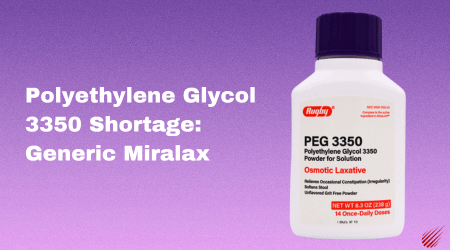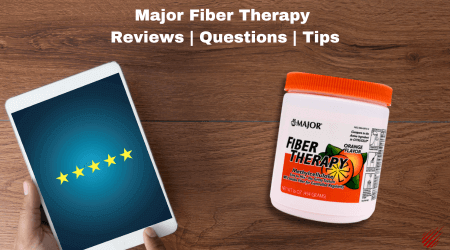
Dealing With the Polyethylene Glycol 3350 Shortage: A Look at Generic Miralax
Polyethylene Glycol 3350 Shortage: Finding Relief with Generic Miralax
A shortage of the active ingredient in MiraLAX has led to increased searches for "Polyethylene Glycol 3350 shortage". MiraLAX is a commonly used osmotic laxative, has been harder to find on store shelves lately and seems to be out of stock everywhere. Weight loss trends on TikTok (i.e. #GutTok) and other social media has created a shortage for consumers who genuinely need the product for constipation relief or colonoscopy prep. This shortage leaves many users searching for an alternative way to relieve constipation and soften stool.
One option is Rugby Polyethylene Glycol PEG 3350 a generic version of MiraLAX with the same active ingredient (polyethylene glycol 3350). Not only does it have the same active ingredient as MiraLAX, but there is also no shortage of supply, and it will save you money over the brand name. Here's a look at how Rugby PEG 3350 compares:
Active Ingredients
Like MiraLAX, Rugby Polyethylene Glycol PEG 3350 contains 17 g of polyethylene glycol per serving and increases the frequency of bowel movements and soften stool. This is the same ingredient found in name brand MiraLAX. See full drug facts label for Rugby Polyethylene Glycol PEG 3350 at the end of this article.
Drug Facts Label: MiraLAX vs. Rugby PEG 3350
| Product | Active Ingredient | Inactive Ingredient |
|---|---|---|
| MiraLAX | Polyethylene Glycol 3350, 17 g | None |
| Rugby Polyethylene Glycol 3350 | Polyethylene Glycol 3350, 17 g | None |
Effectiveness
According to customer reviews, Rugby Polyethylene Glycol PEG 3350 provides comparable results to MiraLAX in terms of relieving constipation. Many users report it regulates their digestive system the same way as the name brand. The product is made in the United States and has passed the same rigorous FDA standards as the brand MiraLAX.
Taste
Rugby Polyethylene Glycol PEG 3350 has little to no flavor making it easy to mix with your favorite drink, similar to common MiraLAX products. Users describe the taste as mild and relatively neutral. If you're looking to improve the taste, you can try some of the tips listed here: How to Make MiraLAX Less Nasty.
Availability
While MiraLAX and other Polyethylene Glycol products have been through shortages, Rugby Polyethylene Glycol PEG 3350 seems to have more consistent availability through online outlets and select retailers. However, availability can vary by location.
Cost
Rugby Polyethylene Glycol PEG 3350 is typically priced lower than the MiraLAX name brand. The Rugby version comes in two different sizes making it a budget friendly option:
- An 8.3 oz bottle costs $11.49 with free shipping.
- A 17.9 oz bottle costs $19.99 with free shipping.
For those dealing with the polyethylene glycol 3350 shortage who have had difficulty finding MiraLAX, Rugby Polyethylene Glycol PEG 3350 may be a suitable alternative to consider until MiraLAX inventory levels normalize. However, as with any supplement, consult your doctor before trying a new osmotic laxative brand.
About xeteor.com
xeteor.com sells high quality generic medications, including Rugby Polyethylene Glycol PEG 3350 Osmotic Laxative at discount prices. We're ranked as the #1 online pharmacy and authorized reseller of Major Pharmaceutical products according to Trustpilot.com. We offer fast free shipping nationwide and free next day service in Las Vegas, Nevada.
Polyethylene Glycol (PEG) Shortage: FAQ
Why is there a shortage of polyethylene glycol (PEG)?
There are a few reasons for the current shortage of polyethylene glycol (PEG):
- Supply chain issues: Manufacturing and transportation disruptions have impacted the supply of PEG. Many PEG suppliers are operating at reduced capacity.
- Increased demand: Demand for PEG has gone up, particularly for medical applications like bowel prep solutions and as an excipient in pharmaceutical drugs. This has led to tight supplies.
- Production issues: Some PEG production facilities have had operational issues like fires, contaminations, and shutdowns for maintenance. This has constrained supply.
- Social Media Misinformation: Trends like #GutTok have increased demand for laxatives.
What is the over-the-counter version of polyethylene glycol 3350?
The over-the-counter version of polyethylene glycol 3350 is MiraLAX. MiraLAX contains PEG 3350 as the active ingredient. It is commonly used as a laxative for the treatment of occasional constipation.
Is there a shortage of stool softeners?
Yes, the PEG shortage has led to supply issues for some over-the-counter stool softeners that contain polyethylene glycol, such as MiraLAX. However, other types of stool softeners that don't contain PEG (like docusate) are still widely available.
Is MiraLAX and PEG 3350 the same?
Yes, MiraLAX contains PEG 3350 as the active ingredient. PEG 3350 is a specific molecular weight of polyethylene glycol that works as an osmotic laxative, drawing water into the intestines to soften stool. So MiraLAX provides a branded over-the-counter version of PEG 3350.
Which is better MiraLAX or polyethylene glycol?
MiraLAX and polyethylene glycol 3350 are essentially the same thing. MiraLAX is the branded, over-the-counter version of PEG 3350. There is no medical difference between the active ingredient in MiraLAX (PEG 3350) and prescription generic polyethylene glycol 3350.
Is there a polyethylene shortage?
Yes, there is currently a global shortage of polyethylene glycol (PEG). This shortage is impacting healthcare, pharmaceutical, and consumer products that utilize PEGs, including laxatives like MiraLAX. The shortage is expected to persist through 2023 due to ongoing supply chain disruptions and increased demand.
What are some alternatives to polyethylene glycol for constipation?
There are a few alternatives to polyethylene glycol for constipation, including:
- Fiber supplements: Fiber supplements, such as psyllium and methylcellulose, can help to increase stool bulk and make it easier to pass.
- Stimulant laxatives: Stimulant laxatives, such as senna and bisacodyl, work by stimulating the muscles of the intestines to contract and push stool out.
- Lubricant laxatives: Lubricant laxatives, such as mineral oil and docusate, help to soften stool and make it easier to pass.
- Osmotic laxatives: Osmotic laxatives, such as lactulose and sorbitol, draw water into the intestines to soften stool and make it easier to pass.
- Dietary changes: Eating a healthy diet with plenty of fruits, vegetables, and whole grains can help to prevent constipation. It is also important to drink plenty of fluids.
Are there any natural remedies for constipation?
There are a few natural remedies for constipation, including:
- Drinking plenty of fluids: Drinking plenty of fluids, especially water, can help to keep stool soft and easy to pass.
- Eating a healthy diet: Eating a healthy diet with plenty of fruits, vegetables, and whole grains can help to prevent constipation.
- Getting regular exercise: Getting regular exercise can help to promote bowel movements.
- Using the toilet when you feel the urge: Don't ignore the urge to go to the toilet.
- Relaxing on the toilet: Relaxing on the toilet can help to make it easier to have a bowel movement.
What are the risks of using too much polyethylene glycol?
Using too much polyethylene glycol can cause side effects, such as:
- Diarrhea
- Nausea
- Bloating
- Abdominal cramps
- Electrolyte imbalance
In severe cases, polyethylene glycol overdose can lead to seizures, coma, and even death.
Full Drug Facts Label for Rugby Polyethylene Glycol PEG 3350
Drug Facts
Active Ingredients
- Polyethylene Glycol 3350 - 17g
- Purpose: Osmotic Laxative
Warnings
- Allergy Alert
- Do not use if you are allergic to polyethylene glycol
- Do Not Use
- If you have kidney disease, except under the advice and supervision of a doctor
- Ask a Doctor Before Use if You Have
- Nausea, vomiting or abdominal pain
- A sudden change in bowel habits that lasts over 2 weeks
- Irritable bowel syndrome
- Ask a Doctor of Pharmacist Before Use if You Are
- Taking a prescription drug
- When Using This Product
- You may have loose, watery, more frequent stools
- Stop Use and Ask a Doctor If
- You have rectal bleeding or your nausea, bloating, cramping or abdominal pain
- These may be signs of a serious condition
- You get diarrhea
- You need to use a laxative for longer than 1 week
- If Pregnant or Breast-Feeding
- Ask a health professional before use
- Keep Out of Reach of Children
- In case of overdose, get medical help or contact a Poison Control Center right away
Directions
- Do not take more than directed unless advised by your doctor
- The bottle top is a measuring cap marked to contain 17 grams of powder when fold to the indicated line (white section in cap)
- Adults and Children 17 years of age and older:
- Use once a day
- Fill to top of white section in cap which is marked to indicate the correct dosage (17g)
- Stir and dissolve in any 4 to 8 ounces of beverage (cold, hot or room temperature) then drink
- Do not combine with starch-based thickeners use for difficulty swallowing
- Entire that the powder is fully dissolved before drinking
- Do not drink if there are any clumps
- Do not use no more than 7 days
- Children 16 years of age or under
- Ask a doctor
Other Information
- Store at 20˚-25˚C (68˚-77˚F)
- Tamper-evident: Do not use if printed foil seal under cap is missing, open or broken
Inactive Ingredients
- None
Disclaimer: This information is intended for informational purposes only and should not be construed as medical advice. Always consult with your doctor or other qualified healthcare professional before using any medication, supplement, or treatment.




